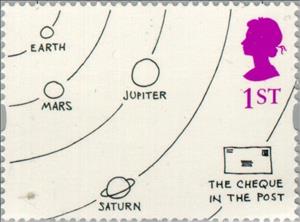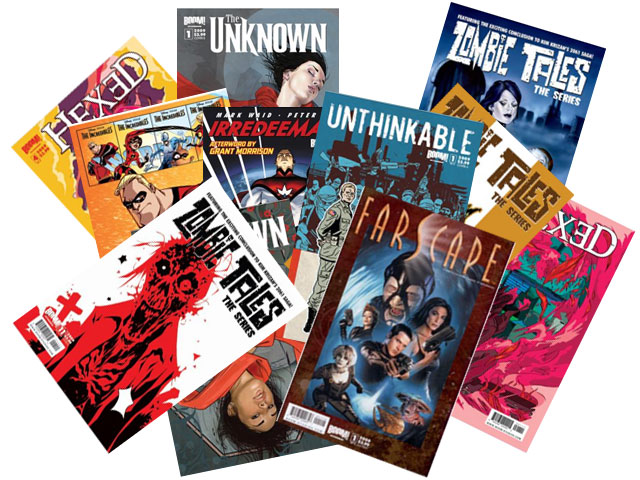Stamp: "THE CHEQUE IN THE POST" (Jack Ziegler) (United Kingdom of Great Britain & Northern Ireland 1996)
"THE CHEQUE IN THE POST" (Jack Ziegler) (United Kingdom of Great Britain & Northern Ireland 1996)
26 February (United Kingdom of Great Britain & Northern Ireland ) within release Greetings Stamp - Cartoons goes into circulation Stamp "THE CHEQUE IN THE POST" (Jack Ziegler) face value 1st Class No Face Value
| Stamp "THE CHEQUE IN THE POST" (Jack Ziegler) in catalogues | |
|---|---|
| Michel: | Mi:GB 1614 |
| Yvert et Tellier: | Yt:GB 1860 |
| Stanley Gibbons: | Sg:GB 1914 |
| AFA number: | AFA:GB 1775 |
Stamp is horizontal format.
Was only issued in booklets, together with the other 9 stamps in the series.Also in the issue Greetings Stamp - Cartoons:
- Stamp - "More! Love" (Mel Calman) face value 1st Class;
- Stamp - "Sincerely" (Charles Barsotti) face value 1st Class;
- Stamp - "Do you have something for the HUMAN CONDITION?" (Leo Cullum face value 1st Class;
- Stamp - "MENTAL FLOSS" (Mel Calman) face value 1st Class;
- Stamp - "4.55 P.M." (Charles Barsotti) face value 1st Class;
- Stamp - "Dear lottery prize winner" (Larry) face value 1st Class;
- Stamp - "I'm writing to you because....." (Mel Calman) face value 1st Class;
- Stamp - "FETCH THIS, FETCH THAT" (Charles Barsotti) face value 1st Class;
- Stamp - "My day starts before I'm ready for it" (Mel Calman) face value 1st Class;
- Stamp - "THE CHEQUE IN THE POST" (Jack Ziegler) face value 1st Class;
Stamp "THE CHEQUE IN THE POST" (Jack Ziegler) it reflects the thematic directions:
The mail or post is a system for physically transporting documents and other small packages; or, the postcards, letters, and parcels themselves. A postal service can be private or public, though many governments place restrictions on private systems. Since the mid-19th century national postal systems have generally been established as government monopolies with a fee on the article prepaid. Proof of payment is often in the form of adhesive postage stamps, but postage meters are also used for bulk mailing. Modern private postal systems are typically distinguished from national postal agencies by the names "courier" or "delivery service". Postal authorities often have functions other than transporting letters. In some countries, a postal, telegraph and telephone (PTT) service oversees the postal system, in addition to telephone and telegraph systems. Some countries' postal systems allow for savings accounts and handle applications for passports.
Drawing is a visual art that uses an instrument to mark paper or another two-dimensional surface. The instrument might be pencils, crayons, pens with inks, brushes with paints, or combinations of these, and in more modern times, computer styluses with graphics tablets.
A cartoon is a type of visual art that is typically drawn, frequently animated, in an unrealistic or semi-realistic style. The specific meaning has evolved, but the modern usage usually refers to either: an image or series of images intended for satire, caricature, or humor; or a motion picture that relies on a sequence of illustrations for its animation. Someone who creates cartoons in the first sense is called a cartoonist, and in the second sense they are usually called an animator.
The concept originated in the Middle Ages, and first described a preparatory drawing for a piece of art, such as a painting, fresco, tapestry, or stained glass window. In the 19th century, beginning in Punch magazine in 1843, cartoon came to refer – ironically at first – to humorous artworks in magazines and newspapers. Then it also was used for political cartoons and comic strips. When the medium developed, in the early 20th century, it began to refer to animated films that resembled print cartoons.
Comics are a medium used to express ideas with images, often combined with text or other visual information. It typically takes the form of a sequence of panels of images. Textual devices such as speech balloons, captions, and onomatopoeia can indicate dialogue, narration, sound effects, or other information. There is no consensus among theorists and historians on a definition of comics; some emphasize the combination of images and text, some sequentiality or other image relations, and others historical aspects such as mass reproduction or the use of recurring characters. Cartooning and other forms of illustration are the most common image-making means in comics; Photo comics is a form that uses photographic images. Common forms include comic strips, editorial and gag cartoons, and comic books. Since the late 20th century, bound volumes such as graphic novels, comic albums, and tankōbon have become increasingly common, along with webcomics as well as scientific/medical comics




